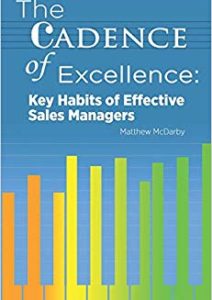Editor’s Note: Today we post Chapter 7 of a 10-chapter book, authored by our CSO, John Golden and Matt McDarby, President of United Sales Resources.
In the previous chapter, we proposed the idea of measuring social selling activities and outcomes. If you’re still reading this book, then perhaps you agree there is value in measuring the effectiveness of your team’s social selling effort. After all, why would we measure only certain, traditional selling activities when we consider just how much we can actually research, learn, and discuss over social media.
Let’s take a step back together, though, and consider what we are measuring and why.
To What End?
Measuring the impact of any sales tactics would be a rather meaningless pursuit if those tactics and their desired outcomes were not tied directly to your team’s important, strategic business objectives.
Let’s take the example of a client of one of ours….
- Very successful revenue-generation team, growing from $400M to $850M in just four years.
- Highly disciplined process for creating value for customers throughout the buying process.
- Specific objectives for major accounts and for regional accounts.
- Strong alignment and collaboration between marketing and sales departments.
- All sales tactics, whether online or offline, are actively observed, coached, and made more effective
This highly disciplined team regularly revisits their important, strategic growth objectives, checking often to see if they are making measurable progress, account by account, opportunity by opportunity, sales call by sales call. They can, at times, get too caught up in measuring sales activities and small outcomes, briefly losing sight of the strategic growth goals that have been clearly articulated by executive leadership and the SLT. Ultimately, though, the main driver for their explosive sales growth has been staying focused on their overall, desired business outcome and taking direct cues from their clients’ key initiatives to determine where heavy investment and sales focus need to be applied. Put simply, they don’t let their regular measurement of selling activities (whether “social” or otherwise) overshadow the big picture.
Neither should you. The social engagement pipeline that we shared in the previous chapter is simply a means to keep sellers focused on the right behavior. In this case, the right behavior is engaging with the right (prospective) buyers about the right issues or opportunities at the right time. That is the essence of great selling, and your task as a sales leader is to use tools and processes that promote that behavior as often as possible. In the client example we’ve just mentioned, that organization employs regular, early-stage pipeline reviews and frequent call and prospecting planning sessions to emphasize the important behavior that has led to and will likely continue to lead to success. Of their sellers who are actively engaged online with buyers (both prospective and existing), many of them receive some regular coaching in which their social networking activities are part of the discussion. Sales managers who have become attuned to the new reality of buying and selling empowered by social media provide the coaching.
Successful Engagement
At the risk of belaboring a key point in this book, we must point out that social engagement for engagement’s sake is not terribly valuable. Successful social sellers are able to demonstrate to prospective buyers that they understand buyers’ business issues and opportunities at a deep level. The purpose and the real value of engagement over social media between seller and buyer is to make a clear connection between important business issues or opportunities and relevant solutions. Buyers will offer their time to those who offer an authentic and empathetic approach to understanding their issues and opportunities. Sellers who socialize but do not demonstrate authenticity and empathy are bound to fail online (just as badly as they fail offline).
Converting contacts and discussions we have over social media to real-world leads and opportunities is generally how success should be defined and measured. In a sense, today’s social selling tactics are neither a substitute nor a replacement for other tried and true methods of engaging with prospective buyers. The interface, reach, and the efficiency of these relatively new social selling methods is all that separates those tactics from warm-calling, email marketing, in person networking, or any other methods whose objective is to fill the pipeline with new opportunities.
The risks of doing social sales poorly are as bad if not worse than the risk of poor email marketing or telephone prospecting. Having applied, experimented, and sometimes failed at all of these methods, we know that customers draw quick conclusions about us and our salespeople, and poor impressions can be difficult to overcome.
What can you do to put your team back on the path to success if they are not consistently able to engage with the right buyers about the right issues at the right time over social media?
- Observe social interactions between your sellers and your prospective customers. Social sales observation can be done asynchronously, unlike the observation of field sales coaches that require a coach’s physical presence and ability to shut up and observe with a customer in the same room.
- Discuss with your seller(s) the outcome(s) of his or her / their social selling interactions. Where did they have success? What positive outcomes have they achieved? Does that offer any clues about how they can engage effectively with other buyers in the future?
- If they cannot point to any successful outcomes, investigate together the quality, timing, appropriateness, customer-focus of social messaging and engagement to determine if improvements can be made. Commit to observing their social interactions, and make time for review together again.
- If they’ve had success, identify what specifically led to that successful outcome, and reward it in an appropriate and relevant way.
To some reading this book, the idea of observing, measuring, and coaching the effectiveness of social selling activities might seem artificial or unrealistic. Perhaps for some, this level of observation and coaching seems like micro-management. We agree that coaching at this level of detail may not be appropriate in many circumstances or for all teams or individuals. In the end, though, we wonder what kinds of sales results should we all expect if we are unwilling to ensure that our salespeople are engaging with the right people about the right issues or opportunities at the right times. What might we be leaving to chance?
Are we willing to put our results at risk simply because we do not fully buy into the notion that selling tactics have to change, and the changes are being driven by client demand?
Key Points From This Chapter
Social engagement for engagement’s sake is nothing. Social engagement must be centered on the idea of demonstrating to prospective buyers that you / your team understand their business issues and opportunities at a deep level.
Sales managers can play a key role in ensuring that their teams are focused on engaging with the right prospective buyers about the right issues at the right time.
Social selling activities can be observed and coached, and in some ways, it may be simpler to observe them compared to field-based coaching. To ignore these activities and to let them go un-coached may mean you are leaving a significant portion of your early-stage opportunity development results to chance.




